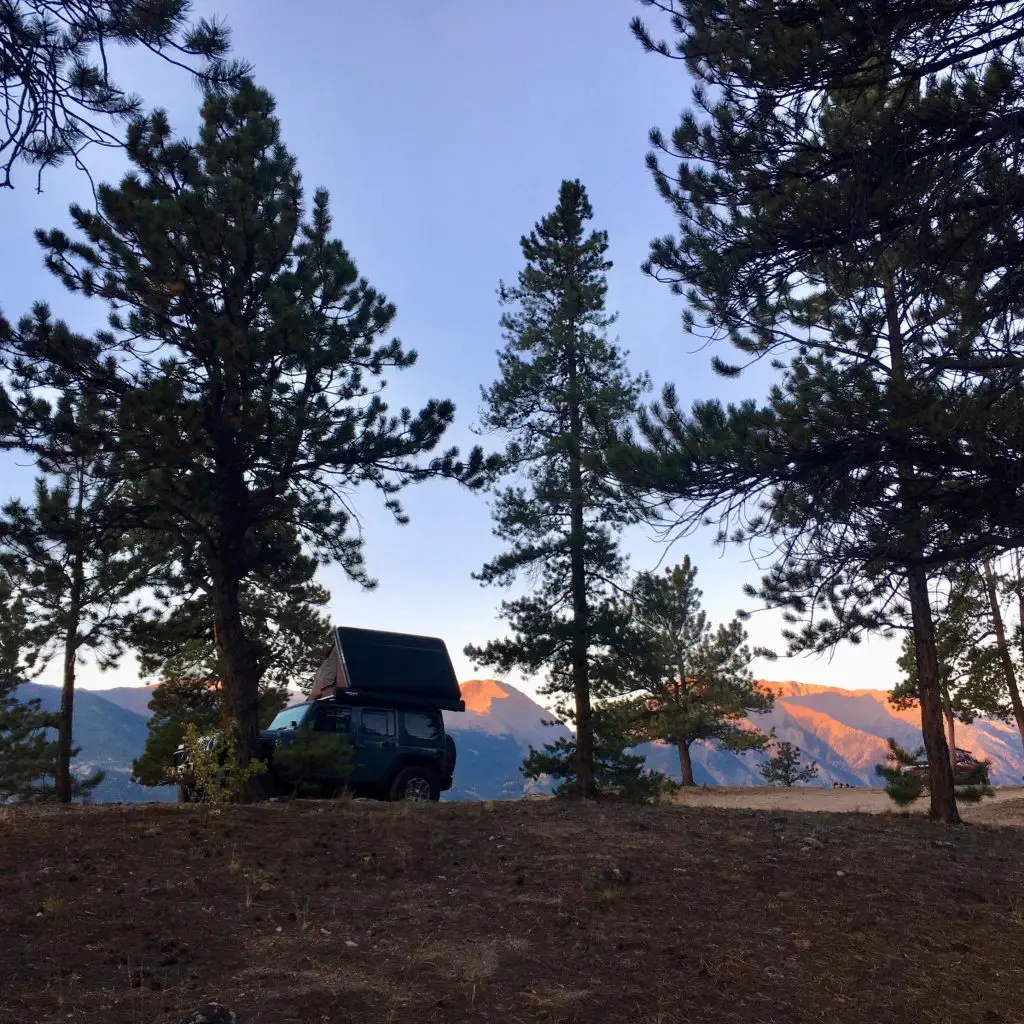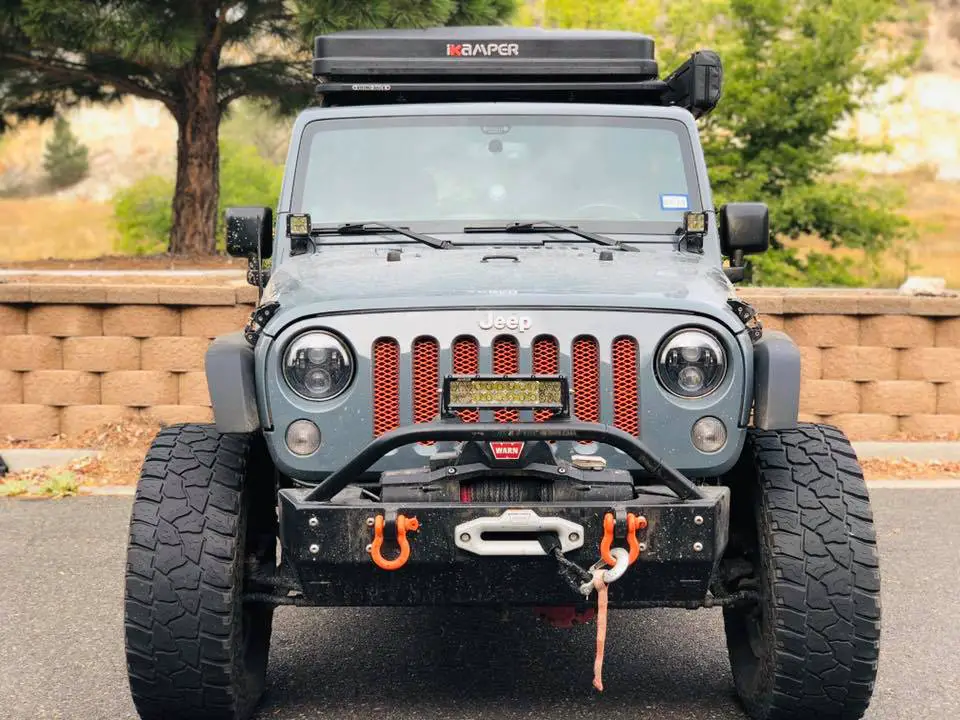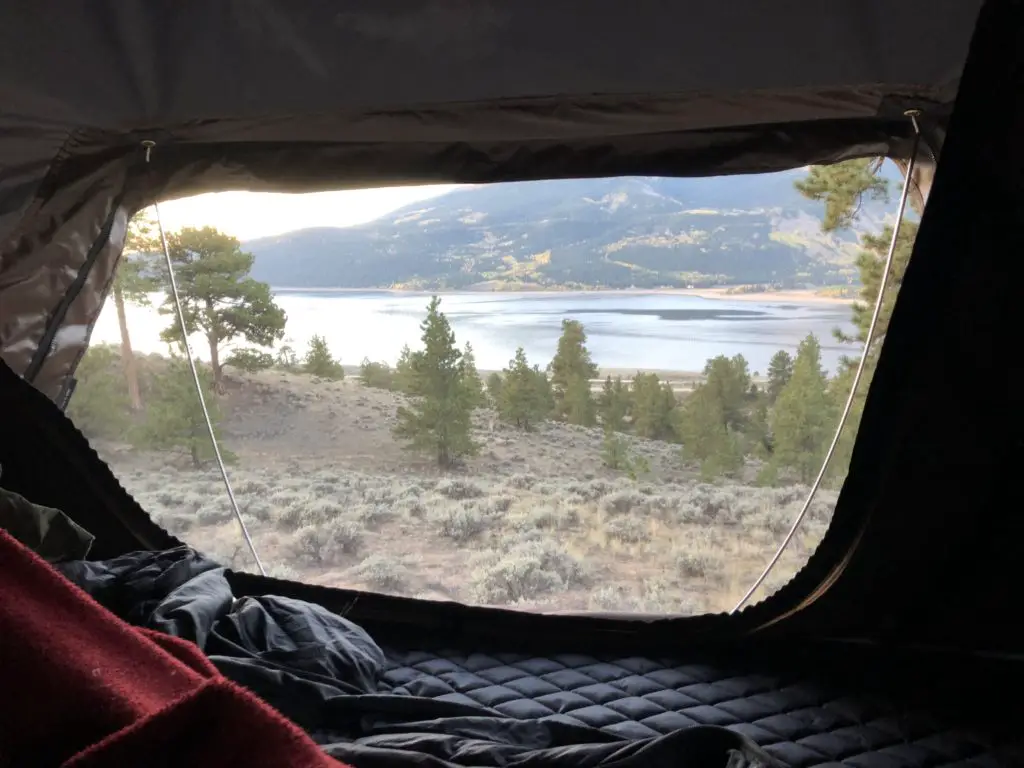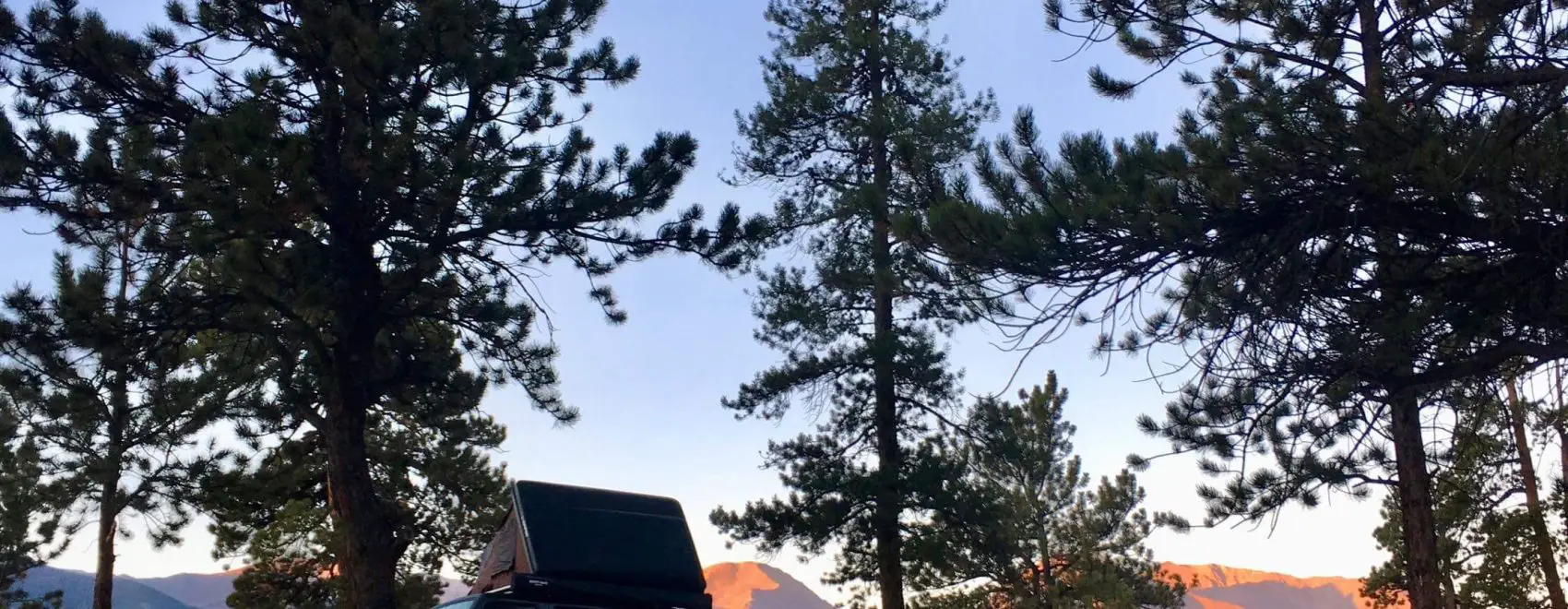
Choosing an overlanding roof top tent setup is a process! We know because we’ve been through it.
There are a ton of things to factor in when making your decision. Combined with the fact there are many reputable manufacturers with solid product lineups, and it really doesn’t make the process any easier.
This article will not be a comparison of overlanding roof top tent setups, but rather an honest breakdown of how and why we landed on our roof top tent configuration.
The process applies to anyone considering an overlanding roof top tent.
(Cover Photo Credit: Marc Terrien)
Step 1: List Your Requirements

We knew what we envisioned. But we didn’t know which product would suit our goals. We started by making a list of our personal requirements for an overlanding roof top tent setup.
Our list included the following 10 requirements:
- Deployment time
- Stowage time
- Sleeping capacity
- Price
- Durability
- Suitability for off-roading
- Comfort
- Weight
- Available accessories
- Shipping and installation
Armed with this information, we were able to narrow down which setups would and wouldn’t work for us. You may have additional requirements. Maybe you have a pet or a specific need. Make sure to tailor your own list.
Step 2: Prioritize Your Requirements

Once we had a list of requirements specific to our needs, we decided to prioritize our most important requirements.
When you prioritize your requirements, make sure you only list the factors that are absolutely essential to you. No overlanding roof top tent is going to meet all of the “requirements” you listed in step 1. So narrow your focus and focus on what is important.
Out of our 10 requirements, four of them were critical for us. By critical, I mean if an overlanding roof top tent didn’t meet these requirements, then it was a no-go.
I’ll elaborate on these four make-or-break requirements a little, in order of importance to us:
Sleeping capacity – There are three of us and one is a toddler. We needed to be able to sleep at least three comfortably, preferably four since a little extra space would be welcome for long-term overlanding. If the tent couldn’t sleep at least three, then it was a deal breaker.
Stowage time – This is more important than you may realize. If you aren’t traveling with a trailer, then you’ll need to move your vehicle frequently. The time it takes to stow your overlanding roof top tent is critical. Think about it. You’re at your campsite, everything is out, and you have to run into town for diapers or something you need immediately. At that moment, you’ll be thankful you considered stowage time when selecting your tent.
Deployment time – Traveling with a toddler presents an extra challenge. We knew once we got to our campsite, one of us was going to need to keep an eye on the little guy, while the other set up camp. The faster we could do this, the better.
Suitability for off roading – We’re off-roaders. We don’t want our overlanding roof top tent setup to hinder us from being able to go off the grid to remote, Instagram-worthy areas.
Keep in mind, these were our critical requirements. Yours may be different. That’s okay; you do you.
Step 3: Start Your Search

Until you’ve completed the two steps above, you’re wasting your time. If you haven’t done them yet, go back now. Then continue onto our step 3.
Honesty: we didn’t follow our own advice. We started by scouring the Internet. It seems we were on every forum out there, watching YouTube videos until our eyes bled.
We did it all wrong.
Having not started with steps 1 and 2 above we were grasping at straws. Do yourself a favor and do the first two steps. You’ll thank me later.
It wasn’t until we made our list and prioritized our requirements that we were able to narrow down our search to the few overlanding roof top tents on the market that were suitable for us.
List in hand, we began doing very specific searches on the Internet, which helped us quickly get to our final list of overlanding roof top tents to consider. We began searching with phrases like:
- 4 person roof top tent
- off-road roof top tent
- fast deployment roof top tent
You get the picture. Those specific searches netted us a shortlist of tents that would potentially meet our needs.
Step 4: Create and Scrutinize Shortlist

Once you’ve started finding tents that may meet your needs, it’s time to create a shortlist.
This is where the process gets fun. It’s getting real now, as you’ve taken the time to hone in on what you’re really looking for.
We narrowed our list down to three overlanding roof top tents:
Ursa Minor Vehicles – This tent was on the top of our list. It’s actually a roof top replacement rather than a roof top tent. Extremely fast deployment and stowage time, very low profile on the vehicle. Super expensive. We found one on sale at a great price. After making a point of seeing one in person, we found it wouldn’t sleep three comfortably. This was a deal breaker for us. If this tent slept four, then it would’ve been a done deal.
James Baroud Grand Raid XXL – This is a super nice tent! Very large, with fast deployment and stowage. Also sleeps three easily. However, the profile wasn’t everything we hoped for when it came to off-road use, which was one of our critical factors. Folks who have this James Baroud say they can feel it on top of the Jeep, and the footprint is rather large. Also, there have been issues with wind noise and reduced MPG for those with this unit. Even with these concerns, this tent was still a consideration for us.
iKamper Skycamp – For those who follow our blog, you know we landed on this tent. More on that in a moment. However, it should be noted that the iKamper checked ALL of our critical requirements, as well as many of our general requirements.
Getting all of your critical requirements and many of your general requirements checked off is the goal. Once you’ve reached that point, it’s time to get serious about whether you are dreaming or doing.
Get Your Overlanding Roof Top Tent Setup

I once told my father-in-law there are two types of people in this world. People who talk about doing things, and people who do them. I added that he’d always find me in the latter group.
We landed on the Rocky Black edition iKamper Skycamp.
As far as our critical requirements, the Skycamp met or exceeded all of them:
- Sleeping capacity – The Skycamp sleeps two adults and two children easily. It has a king-size mattress.
- Stowage time – From full deployment, it takes one person less than two minutes to stow the Skycamp.
- Deployment time – From completely stowed to ready to sleep, the Skycamp takes less than 45 seconds to set up.
- Suitability for off roading – The Rocky Black edition features a hardshell with a textured matte black finish. This finish holds up to branches and rocks a little better than pretty much any other overlanding roof top tent we looked at.
As far as our general requirements, the Skycamp met most of them with ease:
- Price – The Skycamp was a bit pricey, but not more so than the others on our shortlist.
- Durability – This remains to be seen. However, the Rocky Black edition should hold up fairly well, and we’ve heard great things from other owners who have been using theirs extensively.
- Comfort – I’m a side sleeper. The 3rd generation mattress in the Skycamp left me with no soreness in my shoulders after the nights we’ve camped in it.
- Weight – The Rocky Black edition texture adds a little weight to the 161-pound Skycamp. We’re probably sitting at around 170 pounds, well dispersed across the roof rack.
- Available accessories – iKamper makes a bunch of accessories for the Skycamp. So there are options for us down the road.
- Shipping and installation – Installation was included and there were no shipping costs. We had our tent installed at Altitude Industries in Colorado, an official installer and distributor of iKamper.
Have You Made Your Choice?

I’d love to hear from any fellow overlanding enthusiasts who have landed on a roof top tent.
The truth is that the perfect overlanding roof top tent is the one that meets your needs. I don’t care if you choose what I chose, or if you went with something completely different. I’d just love to hear what you chose and why.
More importantly, I’d love to hear about all of the amazing places you’ve found to use your overlanding roof top tent. We genuinely enjoy meeting others in the Jeeping and overlanding community. So don’t be shy to leave us a comment below.
I hope this article has been helpful to you. Please share it with any friends who are considering getting an overlanding roof top tent.
Until next time, keep it dirty and wheels side down.
~ Eric




Curious why the roof top rent rather than an overland trailer. Seems like the trailer would have had cooking space etc.
A trailer is not out of the question. But this is an “experiment” for us. You know we want to travel the world, we’re starting off with this setup for mobility and learning more about what we want out of overlanding. If we decide to go the trailer route down the road, the iKamper can be moved to the trailer and the Rhino Rack on the Jeep could be used for other more specific overlanding gear. We’re keeping our options open. Having said that, the set up and breakdown time of our current build is unimaginably fast! Just yesterday I popped the tent open for family who was visiting and they were all in shock at how fast it was to deploy. Then I broke it down in under two minutes. Again, when you can set up and breakdown in under 3 minutes total for both, the RTT is not a bad trade off for having to do so in order to take off in the Jeep. Trailers also have their drawbacks. Like I said, we’ll see. About cooking space, there are plenty of options for self-contained cooking areas using the Jeep as a platform. The biggest drawback to the JKU (Jeep Wrangler Unlimited) for overlanding is the payload capacity of 1179lbs. However, with the right gear it is completely doable. Hope that helps.
Hey Eric!
How has the tent been holding up? We are conserdering our tent for our 4runner in addition to our van. I have pretty much landed on the James Baroud, and the lkamper. It is just my wife and I (but, the grandkid could enter the picture on road trips in the next few years). I like the JB since it is just the footprint of the vehicle, but the same time, I like the shelter aspect that is created by the over hang of the Ikamper for an encloser. Having a private space for a camping toilet, changing room or solar shower would be great. But that could also be accomplished from an awning or pop up changing room when needed. Since we are just starting out, I’m looking to your experience. How is your tent holding up, now that you have had it for awhile (not sure how long you have had it before the date of your article)?
I look forward to hearing about it.
Oh, Where in Mexico are you going? We loved the Baja, wish we had our 4runner there for getting off the pavement.
Cheers man,
Jay Lestenkof
Man so sorry I didn’t see this earlier Jay! We’ve had our head down preparing for our Mexico trip. I’m actually responding to you from San Luis Potosi in Mexico. So the short answer is the iKamper no question. The Baroud is nice, we looked at them too. But they tend to have too large of a footprint for most vehicles and the aerodynamics suck with them up there. The iKamper sleeps 4 comfortably, you can add an annex room (which we have) that is huge! Also I’m getting 18.1 mpg in my Jeep fully loaded for extended overlanding with the ikamper on top and three people in the Jeep so there’s that. Let me know if you have any other questions. I’d highly recommend you reach out to Lee Hoffman at Altitude Industries with any questions on iKamper installation or purchase. He’s the one we went through and I can’t recommend him highly enough. He’s installed hundreds on every vehicle you can imagine.
Eric,
Thanks for the response and details, no problem on the delay, it probably won’t be till spring until we make a move with all of the travel expenses we have had the last 3 months. Thanks for the info on where you got yours.
Cheer my friend!
Jay
Hola from Peru! Is the Ursa Minor the only rooftop tent where you can enter through the roof of your Jeep? I have me and my Husky and an outside ladder is not an option. I love Chris Shontz’s set up from Venture4wd.com This type of “enter through the roof” setup is what I will be looking for when I return to Florida.
Mac
Hola Mac! To be clear the Ursa Minor Vehicles is an incredible option but technically it is not a roof top tent. It is actually a roof top replacement which includes a tent. In order to use the Ursa Minor J30, you’ll need to replace your hard top with the entire offering. This is what allows it to have access from the interior, and as a result I believe it is the only “RTT” that is available for the Jeep that allows interior access though I could be mistaken. Figure it this way, you might could make another RTT work in the same fashion but unless you’d be willing to cut off the entire top of your Jeep and do some serious fab work that would require damaging structural integrity, you’d have to replace the hard top anyway. The downside to the Ursa Minor is that it is only designed to sleep 1-2, you can’t take it off if needed as it is an entire replacement. And though the IG photos make it look super easy the reality is that most overlanders keep a metric ton of stuff in the back which would then need to be moved out in order to maximize its usefulness while camping. Hope that helps. ~ E